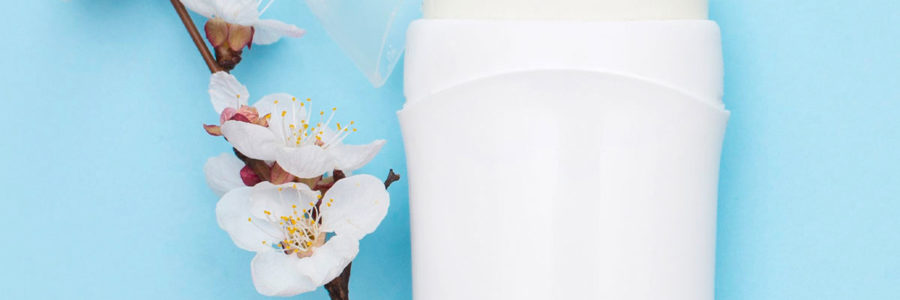Body odor is an embarrassing situation many of us have dealt with at least once in our lives. While there are many commercial deodorants available, many people are unaware of the natural options that are available. This article will discuss how a person can solve issues with body odor by making their own deodorant using natural ingredients.
![]()
This article has been medically reviewed by Dr. Charles Penick, MD![]()
Natural Deodorant Stick Recipe
Natural Deodorant Spray Recipe
Non-DIY Options for Natural Deodorant
Why Use Natural Deodorant?
There are several reasons why using natural deodorant instead of commercial varieties is a healthier choice. For starters, the harmful ingredients used in unnatural deodorants have been linked to a variety of health issues. Most commercial antiperspirants contain aluminum salts, which have been shown to cause both DNA alterations and epigenetic effects, which could play a role in the formation of breast cancer.1
Many deodorants also contain triclosan, an ingredient used to kill bacteria. Studies on lab animals indicate triclosan reduces thyroid hormones, ultimately leading to “deficits in reproductive endocrine and function.” 2
Another potentially harmful ingredient is parabens, a preservative used in commercial deodorants, toiletries, and cosmetics. Studies indicate parabens can accumulate in the body, particularly in the breast. Studies are ongoing to identify a potential link between the accumulation of parabens and breast cancer.3
In addition, antiperspirants block the pores, which prevents a person from sweating. Sweating plays a key role in good health: it is one of the ways the body rids itself of toxins through the skin.
How to Make Natural Deodorant
You can easily make homemade deodorants using natural products in stick or spray varieties. Unlike commercial deodorants, which could be harmful to the body or skin, natural deodorants are healthier and good for the body. In the next section, we will list two deodorant recipes with ingredients and instructions on making them.
Natural Deodorant Stick Recipe
Natural deodorants typically consist of the following ingredients:
- The base (shea butter, coconut oil)
- A powder mixture (baking soda)
- Arrowroot powder
- Essential oils (based on individual preference)
Recipe #1 (Clink on the links to order any ingredients you may need):
- 2 tablespoons of shea butter
- 3 tablespoons of baking soda
- 3 tablespoons of coconut oil
- 2 tablespoons of arrowroot powder
- 15-30 drops of essential oil (popular essential oils for natural deodorant include lavender, tea tree, lime, grapefruit, bergamot, lemon, clary sage, and wild orange)
- 1 saucepan
- 1 Mason jar (quart size)
Instructions
- Place the shea butter and coconut oil in a Mason jar
- Slowly melt over low flame (do not overheat)
- Remove from flame and let cool
- Add baking soda and arrowroot powder, then mix thoroughly
- Add the 15-30 essential oils of your choice (you can use a combination of your favorite essential oils)
Final Steps
- Pour all ingredients into a deodorant bar or airtight container
- Use a popsicle stick to get the contents out of the container
- Experiment with various amounts to determine how much you will need to apply daily (it can vary from person to person, but the average is a pea size or slightly more)
Bonus Tip: Another popular ingredient to use in natural deodorant is ½ teaspoon of activated charcoal. Activated charcoal can absorb smells and help absorb excess moisture.
Natural Deodorant Spray Recipe
In addition to natural deodorant sticks, sprays are also available. However, the spray is different because it is 100% liquid: it doesn’t contain the base ingredients of shea butter and coconut oil used in the stick.
Here is a natural deodorant spray that you can easily make at home:
Ingredients
- 2 tablespoons of vodka
- 2 tablespoons of distilled water
- 2 drops of essential oil (rose)
- 2 drops of essential oil (jasmine)
- 2 drops of essential oil (orange)
- 1 drop of essential oil (lavender)
- 2-ounce, dark-colored spray glass bottle
Note: Other essential oils can be used per individual preference. See a variety of essential oils HERE.
Instructions:
- Pour water and vodka into a dark-colored spray bottle
- Add the essential oils to the mixture
Note: Using the highest proof of vodka will increase the potency of the natural deodorant.
Non-DIY Options for Natural Deodorant
In addition to creating your own natural deodorant, you can also find pre-made deodorants that are more natural-based.
Final Thoughts
Commercial deodorants contain many ingredients, such as aluminum, parabens, and triclosan, that may be hazardous to a person’s health. To avoid these potential dangers, the popularity of natural deodorants has increased over the years. In addition, many find it fun to make their own deodorant with their favorite essential oils.
Which essential oils are your favorites? Do you prefer the spray or stick? Leave us a comment and share your experiences! Give these natural deodorant recipes a try; your body will thank you!
Medical Disclaimer: The information on this website is not intended to replace a one-on-one relationship with a qualified healthcare professional and is not intended as medical advice. It is intended as a sharing of knowledge and information. This article has been medically reviewed by Dr. Charles Penick, MD, for the accuracy of the information provided. Still, we encourage you to make your own healthcare decisions based on your research and in partnership with a qualified healthcare professional.
References
- P D Darbre. Aluminium, Antiperspirants And Breast Cancer. 2005 Sep;99(9):1912-9. doi: 10.1016/j.jinorgbio.2005.06.001. [PMID: 16045991]. https://pubmed.ncbi.nlm.nih.gov/16045991/
- Xin-Yuan Cao 1 2, Xu Hua 2, Jian-Wei Xiong, ((et al). Impact of Triclosan on Female Reproduction through Reducing Thyroid Hormones to Suppress Hypothalamic Kisspeptin Neurons in Mice. 2018 Jan 19;11:6. doi: 10.3389/fnmol.2018.00006. eCollection 2018. [PMID: 29403355]. https://pubmed.ncbi.nlm.nih.gov/29403355/
- P D Darbre, A Aljarrah, W R Miller, N G Coldham, (et al). Concentrations Of Parabens In Human Breast Tumours. Jan-Feb 2004;24(1):5-13. doi: 10.1002/jat.958. [PMID: 14745841]. https://pubmed.ncbi.nlm.nih.gov/14745841/


